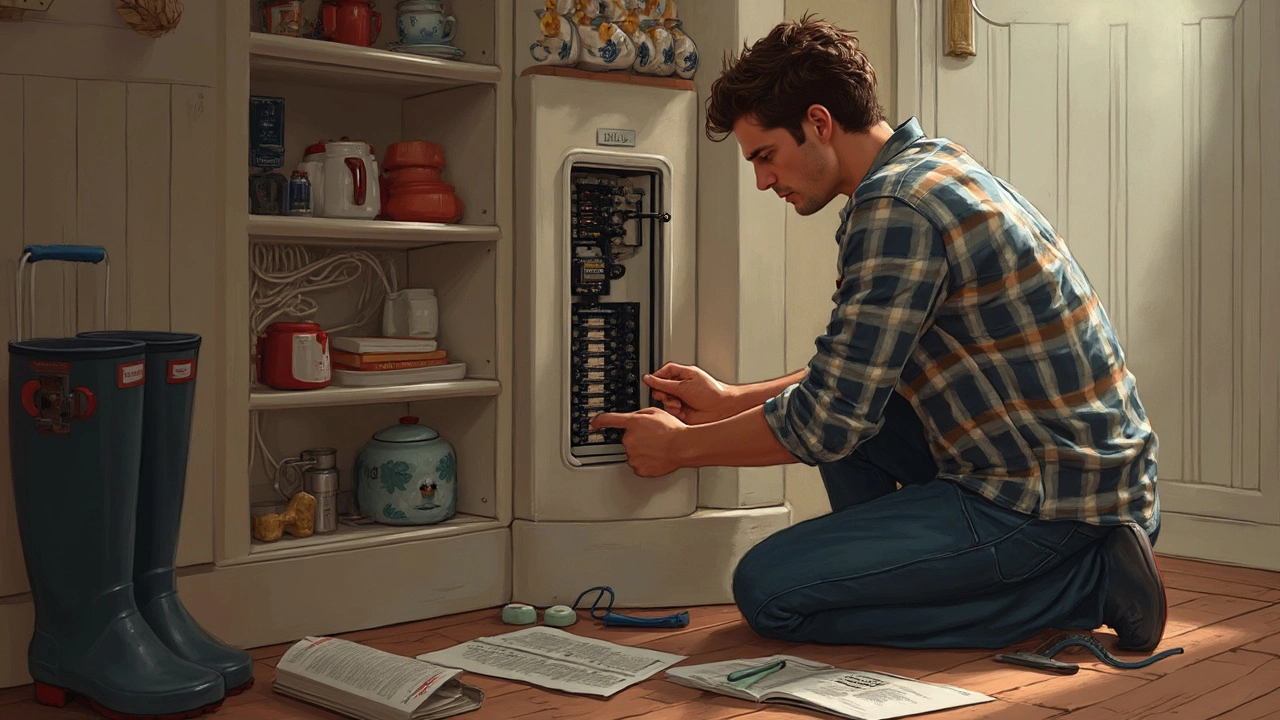You're in the middle of a shower, shampoo in your hair—and bam, cold water. It's frustrating and sometimes feels like your water heater just picked its moment to mess with you. Before you grab your phone to Google a plumber, don't panic. There are a few super common reasons why hot water can disappear all of a sudden, and some of them are easier to fix than you might think.
For starters, think about the last time you ran a bunch of appliances at once—shower, dishwasher, maybe someone was doing laundry. Hot water tanks only hold so much, and sometimes they just run out. But if you're sure it shouldn't be empty, you could be dealing with a flipped breaker, a faulty pilot light, or even a tripped reset button.
It's not always a big job. Most people are surprised that a water heater reset can be as easy as pushing a button or flipping a switch. Just remember, always cut the power before you go poking around. Safety first, always. I'll walk you through the quick checks and tips before you spend a dime calling for help.
- When Hot Water Disappears Out of Nowhere
- The Fastest DIY Checks (and How to Do Them Safely)
- Hidden Issues That Steal Your Hot Water
- When It's Time for Professional Help
When Hot Water Disappears Out of Nowhere
The feeling when you suddenly run out of hot water is unforgettable. One minute you’re fine, the next you’re freezing. But where did all that warm water go? Let’s break it down with some real-world info and fixes.
Most homes rely on a tank-style water heater. These can only hold so much hot water at a time—usually 40 to 50 gallons in U.S. homes. When the tank empties (think back-to-back showers or running dishes and laundry together), you get cold water until it reheats. With electric models, full reheat takes about an hour; gas ones recover a bit faster.
Water heater not working? It’s not always about the demand. The two main types—electric and gas—fail for different reasons. For electric heaters, a tripped circuit breaker or a popped reset button is common. Gas units might have an extinguished pilot light or a broken thermocouple. Anything that kills power or gas flow means no hot water for you.
- Check if you have any power outages or weird electrical flickers. Electric water heaters are super sensitive.
- Gas heater? Sometimes even a small draft can blow out the pilot light. Some newer models have electronic ignition rather than an old-school flame.
- If your water heater is over 10 years old, random shutdowns start happening more often. Most tanks only last 8–12 years—anything more and you’re on borrowed time.
Here’s a quick comparison for average recovery times after emptying the tank:
| Type of Water Heater | Average Recovery Time |
|---|---|
| Electric | 60-80 minutes |
| Gas | 30-40 minutes |
If there’s no hot water and nobody just used a ton, the culprit is likely a power, gas, or mechanical issue. We’ll get into the basic checks you can try yourself next.
The Fastest DIY Checks (and How to Do Them Safely)
If your no hot water situation came out of nowhere, don’t jump straight to the worst-case scenario. Most times, the fix is simple and right in front of you. Here’s how you can do a quick check-up on your water heater repair needs—no degree in plumbing required.
- Check the Power. Electric water heaters depend totally on the breaker box. Find your home's electrical panel and look for a switch labeled "water heater." If it’s in the middle or "off" position, flip it back to “on.” If it immediately trips again, stop—there’s a deeper issue.
- For Gas Heaters: Inspect the Pilot Light. Look for a small window or panel near the bottom of your heater. If that little flame is out, your water heater won’t make a peep. You’ll usually find relighting instructions on the side of your tank. Turn the gas knob to “off” first, wait a few minutes, then follow the steps carefully. If you smell gas, leave it alone and call for help.
- Try the Reset Button. For electric heaters, look for a red button (or sometimes black) on the thermostat, under a panel on the tank. Press it firmly—you might hear a "click." Wait about 15-20 minutes to see if the water starts to heat up again.
- Check the Thermostat Setting. Sounds basic, but temperature dials can get bumped. Make sure it’s set somewhere between 120°F and 140°F. Lower than that, and it won’t get properly hot.
- Peek for Leaks. Water around the base? That’s never good. It could be condensation, but it might also be a busted tank.
“If your water heater quits, check the circuit breaker and reset button before anything else. These two steps fix around 40% of residential hot water complaints, no joke.” — Jeff W., licensed master plumber
| Common Cause | Quick Fix | Safe for DIY? |
|---|---|---|
| Breaker Tripped | Flip breaker to ON once | Yes |
| Pilot Out | Follow tank instructions to relight | Yes (unless you smell gas) |
| Reset Needed | Press reset button | Yes |
| Leaking Tank | Call a pro | No |
Always turn off power at the breaker before poking around an electric tank. Gas tanks? Don’t mess with anything if you smell gas or see damage. That’s pro territory. With these fix hot water tips, about half the time you'll get the hot water flowing again without drama.

Hidden Issues That Steal Your Hot Water
So, you flipped the breaker and checked the pilot light, but you’re still dealing with an ice-cold shower. This is where the sneaky problems come in—the ones most folks don’t even realize mess with their hot water.
One classic culprit is a broken heating element if you’ve got an electric water heater. These elements wear out over time, especially if you have hard water in your area. If just one burns out, it might look like your heater is working but you never get enough hot water. Sometimes, you’ll get a short burst of warmth, and then it’s back to cold.
For gas units, a bad thermocouple or a dirty burner can knock out your supply. The thermocouple is what tells the system when to keep heating the water. If it’s covered in gunk or bent, the gas supply shuts off as a safety move—leaving you with no hot water at all.
Don’t forget about sediment buildup. If your water sounds like it's popping or rumbling, you’re probably dealing with a layer of muck at the bottom of the tank. That buildup acts like an insulating blanket, making your heater work way harder for less payoff. Not only can that tank get less efficient, but sediment can also kill your heating elements.
Here are some less obvious problems you might run into:
- Leaking tank – If your tank is leaking, you’ll never get enough hot water. Water slips out, and the system can’t keep up.
- Faulty thermostat – If your thermostat is stuck on a low setting (or just busted), the hot water never really gets hot, no matter how long you wait.
- Dip tube issues – This is a plastic tube inside the tank that pushes cold water to the bottom where it can be heated. If the tube cracks or breaks, cold water mixes right in with the hot and cools everything down.
- Undersized water heater – If you’ve remodeled and added another shower, or your family’s grown, your old heater might just be too small for your new needs.
Check out this quick table of common hidden problems and what usually gives them away:
| Issue | Typical Sign |
|---|---|
| Broken Heating Element | Water lukewarm or cold after a few minutes |
| Sediment Buildup | Popping sounds, slow reheating, cloudy/rusty water |
| Leaking Tank | Puddle near heater, always low on hot water |
| Bad Thermostat | Consistently low temperature |
| Dip Tube Failure | Sudden cold water with otherwise working tank |
Catching these hidden issues early can save you a lot of money and avoid that rude surprise of a cold shower. If you spot any of these signs and aren’t sure how to handle them, it might be time to call in a professional for a real fix before things get worse.
When It's Time for Professional Help
Sometimes, home fixes just won't cut it, and that's when you should call in a pro. If you've messed with the reset button, checked breakers, and can’t spot anything obvious, something big could be going on with your water heater—and you really don’t want to mess this stuff up. Gas leaks, electrical faults, and a tank that's leaking water can be risky for anyone who isn’t a certified technician.
So, how do you know when it’s beyond a DIY fix?
- Mysterious leaks around the tank, or puddles at the base? That can mean the tank has rusted through. No easy repair—replacement is usually the only move.
- If you smell natural gas near your water heater (that rotten egg smell), don't try to relight the pilot or mess with the unit. Exit the house and call your gas company or fire department right away.
- A breaker that keeps flipping every time the unit heats up? You might have a wiring issue or heating element shot. This isn’t just inconvenient—it can be a real fire hazard if you keep ignoring it.
- No hot water even after you reset everything and double-checked the thermostat? The heating elements or thermostat itself could be shot, and replacements can require special tools.
- Odd, loud popping or banging sounds mean sediment might be burning onto the bottom. Too much buildup can ruin the tank or even make it unsafe, and a pro has the right tools to flush it out.
Lots of homeowners think waiting will save money, but delay can actually lead to higher bills or water damage. Waiting on a broken water heater could mean hundreds of gallons of water leaking into your floors, and water damage repairs are never cheap.
| Repair Type | Average Cost (USD) |
|---|---|
| Replace heating element | $150 - $350 |
| Fix electrical issues | $100 - $300 |
| Replace water heater tank | $1,000 - $2,500 |
If you’re not sure, talk to a real pro—they’ll know if the fix is quick or if you need to plan for a new unit. And if you’re dealing with anything that looks dangerous, like gas or major leaks, stop and call for help. Your safety and your wallet will thank you.


